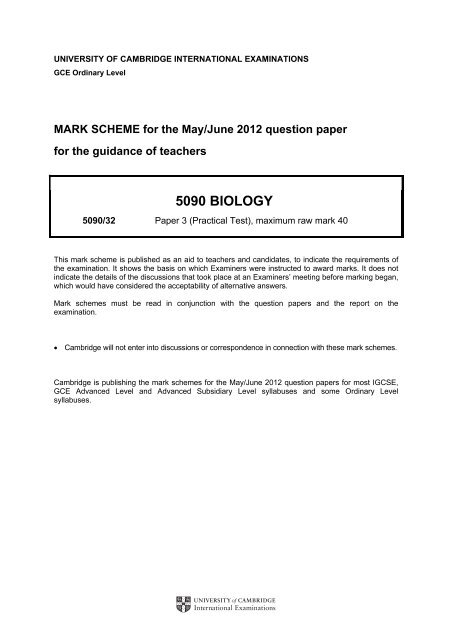5090 BIOLOGY
5090 BIOLOGY
5090 BIOLOGY
Create successful ePaper yourself
Turn your PDF publications into a flip-book with our unique Google optimized e-Paper software.
UNIVERSITY OF CAMBRIDGE INTERNATIONAL EXAMINATIONS<br />
GCE Ordinary Level<br />
MARK SCHEME for the May/June 2012 question paper<br />
for the guidance of teachers<br />
<strong>5090</strong> <strong>BIOLOGY</strong><br />
<strong>5090</strong>/32 Paper 3 (Practical Test), maximum raw mark 40<br />
This mark scheme is published as an aid to teachers and candidates, to indicate the requirements of<br />
the examination. It shows the basis on which Examiners were instructed to award marks. It does not<br />
indicate the details of the discussions that took place at an Examiners’ meeting before marking began,<br />
which would have considered the acceptability of alternative answers.<br />
Mark schemes must be read in conjunction with the question papers and the report on the<br />
examination.<br />
• Cambridge will not enter into discussions or correspondence in connection with these mark schemes.<br />
Cambridge is publishing the mark schemes for the May/June 2012 question papers for most IGCSE,<br />
GCE Advanced Level and Advanced Subsidiary Level syllabuses and some Ordinary Level<br />
syllabuses.
Page 2 Mark Scheme: Teachers’ version Syllabus Paper<br />
GCE O LEVEL – May/June 2012 <strong>5090</strong> 32<br />
1 (a)<br />
initial height<br />
final height after 30 mins<br />
change in height<br />
height of dough / mm<br />
S1<br />
S2<br />
1 – initial two readings – should be similar (within 5 mm)<br />
1 – for final two readings;<br />
1 – change according to figures given;<br />
1 – change in height – positive(+) to be given in S1. [4]<br />
(b) (i) S1 increased more / S2 very little change;<br />
Credit for use of figures;<br />
shows bubbles / gas / froth in S1 (on the surface of dough) or converse in S2; meniscus.<br />
[max 3]<br />
(ii) aerobic / anaerobic;<br />
respiration;<br />
release of carbon dioxide / gas;<br />
trapped inside the dough causing it to rise;<br />
more S1 / ORA; [max 3]<br />
(c) same dough mixture;<br />
at least three of temperatures within acceptable range;<br />
incubate the yeast mixture at set temperature;<br />
measure height (by levelling top of mixture); compare;<br />
repeat to increase reliability;<br />
control without yeast;<br />
calculate mean; [max 5]<br />
[Total: 15]<br />
2 (a) Drawing – clear outline of leaflets (minimum of three) attached to a branch (no shading);<br />
proportion – minimum of 7 cm;<br />
lamina (midrib double line )+ petiole; serrated margin; [max 3]<br />
Labels – lamina / blade; midrib / veins,<br />
petiole / leaf stalk; bud / stipule at base [max 2]<br />
(b) Photosynthesis;<br />
Flat / thin leaf plus ref to gaseous exchange / diffusion / light penetration;<br />
(Green) chlorophyll plus ref to absorption of light;<br />
Leaf with large surface area plus ref to gas exchange / light;<br />
Attachment – transport (if correct) to stem / veins. [max 3]<br />
(c) Reference to the leaf closing around or over insect / leaf margins forming trap / ref to pointed<br />
structures [1]<br />
© University of Cambridge International Examinations 2012
Page 3 Mark Scheme: Teachers’ version Syllabus Paper<br />
GCE O LEVEL – May/June 2012 <strong>5090</strong> 32<br />
(d) (i) Nitrate / nitrogen containing compound / phosphate; [1]<br />
Not nitrogen alone<br />
(ii) Enzymes / proteins / nucleic acids / DNA / cell membrane / forms new protoplasm /<br />
growth / chlorophyll; [1]<br />
[Total: 11]<br />
3 (a) (i) Stamen / anther / pollen sac correctly named / indicated [1]<br />
(ii) Stigma / stigmatic surface correctly identified / named [1]<br />
(b) (i) Prepare solution / tissue / cut up / grind in water;<br />
Add Benedict’s solution; heat; one safety feature e.g. in water bath / use of tongs /<br />
gloves / lab coat;<br />
Expected colour change if positive; [max 4]<br />
A – brown qualified e.g. reddish (for orange).<br />
R – incorrect colour change<br />
A – use of clinistix – max 3 marks<br />
(ii) Green / yellow / red; [1]<br />
(c) (i)<br />
time / hours<br />
length / mm<br />
0.0 (0)<br />
2.0 18 – 20<br />
4.0 23 – 25<br />
6.0 28 – 30<br />
8.0 34 – 36<br />
10.0 41 – 43<br />
A – ranges shown but units not required.<br />
A – 2 marks for no errors<br />
A – 1 mark for one error<br />
[2]<br />
(ii) Orientation of axes with time (t) on X axis & length on Y axis;<br />
Clear plots to cover at least half of the grid and with zero indicated;<br />
Neat line drawn (connections ruled / line of best fit). [3]<br />
(iii) Growth faster in first 2 hours (at first) then becoming slower / constant; [1]<br />
(d) Towards chemical / hormone (in ovule); [1]<br />
[Total: 14]<br />
© University of Cambridge International Examinations 2012

















